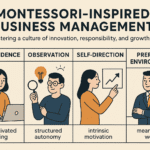
Chapter 1: Foundations of Montessori in Business
1.1 What is Montessori and Why Does it Matter in Business?
The Montessori philosophy, originally designed for education, is built on principles of independence, observation, self-direction, and a prepared environment.
These same principles can be applied to business management to foster a culture of innovation, responsibility, and growth.
By focusing on self-motivated learning and structured autonomy, businesses can cultivate workplaces where employees thrive through intrinsic motivation and meaningful work.
1.2 Key Montessori Principles for Business Success
Montessori is grounded in core principles that translate well into business:
- Respect for the Individual: Employees, like students, work best when they are trusted to manage their own tasks.
- Prepared Environment: A structured yet flexible workspace encourages productivity.
- Observation: Leaders can make informed decisions by carefully observing employee behavior and workflow.
- Self-Directed Learning: Encouraging employees to take ownership of their development leads to innovation and job satisfaction.
1.3 The Role of the Environment in productivity
Montessori classrooms are meticulously designed to promote focus, organization, and efficiency.
Similarly, a well-prepared business environment—whether a physical workspace or a digital framework—affects employee performance.
Thoughtfully designed workspaces can:
- Minimize distractions
- Encourage creativity
- Enhance collaboration
- Promote psychological well-being
1.4 Fostering Independence in Teams
Rather than dictating every action, Montessori principles encourage self-reliance. In a business context, this means:
- Allowing employees to take responsibility for their projects.
- Encouraging problem-solving without micromanagement.
- Developing accountability through ownership of work.
A workplace that fosters independence leads to higher engagement, innovation, and job satisfaction.
1.5 The Power of Self-Directed Learning
Montessori education encourages students to explore subjects at their own pace. Businesses can apply this principle by:
- Offering continuous learning opportunities.
- Encouraging employees to set professional development goals.
- Providing mentorship and coaching rather than top-down instruction.
When employees are encouraged to seek out knowledge and skills independently, they become more engaged and valuable to the organization.
1.6 Balancing Freedom and Structure in the Workplace
Freedom within limits is a key Montessori tenet. In business, this means:
- Giving employees autonomy while maintaining accountability.
- Creating clear goals without rigid workflows.
- Encouraging creativity within a structured framework.
A successful business model embraces both structure and flexibility to empower employees.
1.7 The Concept of the Prepared Environment
The Montessori approach relies on a carefully curated environment that fosters learning and independence. A business can do the same by:
- Designing office spaces that encourage focus and collaboration.
- Providing tools and resources that allow employees to work efficiently.
- Creating digital infrastructures that support workflow automation and self-management.
1.8 Observation as a Core Leadership Skill
Montessori teachers use observation to understand student needs. Business leaders can apply this by:
- Watching for patterns in employee behavior.
- Identifying strengths and areas for growth.
- Adjusting workflows and policies based on real-time insights.
Observation allows leaders to make informed decisions rather than relying solely on assumptions or rigid policies.
1.9 The Leader as a Guide, Not a Boss
Montessori educators act as guides rather than authoritative figures. Business leaders can adopt this approach by:
- Facilitating rather than dictating.
- Encouraging employees to develop their own solutions.
- Leading by example rather than command.
This leadership style builds trust, responsibility, and long-term employee engagement.
1.10 Redefining Success: Beyond Profits
A Montessori-inspired business does not define success solely in financial terms. Other key success indicators include:
- Employee satisfaction and well-being.
- Innovation and continuous improvement.
- Positive workplace culture.
- Contribution to the broader community.
By adopting a holistic view of success, businesses can create sustainable and meaningful growth.
Chapter 2: The Prepared Work Environment
2.1 The Role of Physical Space in Business Efficiency
A well-designed workspace enhances productivity by reducing distractions and creating an atmosphere conducive to deep work.
Thoughtful office layouts, ergonomic furniture, and functional tools contribute to a prepared environment that supports efficiency.
2.2 Designing a Montessori-Inspired Office
Applying Montessori principles to office design involves creating spaces that promote focus, collaboration, and autonomy.
Work areas should be well-organized, free from clutter, and adaptable to different working styles.
2.3 Open vs. Structured Workspaces: Finding the Balance
While open offices foster collaboration, structured spaces allow for concentration.
Businesses should design environments that offer both, allowing employees to choose the setting that suits their work best.
2.4 Choosing the Right Tools and Resources for Employees
Providing the necessary tools—both physical and digital—empowers employees to work effectively.
Businesses should focus on equipping teams with intuitive technology, clear documentation, and streamlined workflows.
2.5 Decluttering for Clarity and productivity
A clutter-free environment reduces cognitive overload and promotes efficiency.
Businesses can implement organizational strategies such as minimalistic office design, digital decluttering, and streamlined communication channels.
2.6 Encouraging Employee Autonomy with a Thoughtful Layout
Designing workspaces that encourage independence allows employees to take ownership of their tasks.
Providing accessible resources and self-service options fosters a sense of responsibility.
2.7 Eliminating Distractions and Creating Focus Areas
Disruptions can hinder productivity.
Businesses should incorporate quiet zones, meeting spaces, and collaborative areas to ensure employees have the right setting for different tasks.
2.8 The Psychological Impact of Order in the Workplace
An organized environment fosters a sense of control, reducing stress and improving employee morale.
Maintaining order through structured workflows and clear expectations enhances workplace efficiency.
2.9 Using Technology to Enhance the Prepared Environment
Leveraging technology for organization, task management, and communication can streamline operations.
Businesses should focus on implementing intuitive systems that facilitate seamless workflows.
2.10 Evolving and Adapting Workspaces Over Time
A prepared environment is never static.
As business needs evolve, companies should continuously reassess and refine their workspaces to support growth and efficiency.
Chapter 3: Self-Directed Teams
3.1 The Power of Autonomy in the Workplace
Autonomy allows employees to take ownership of their work, fostering engagement and motivation.
Businesses that encourage autonomy see increased innovation and accountability among team members.
3.2 Replacing Micromanagement with Trust
Micromanagement stifles creativity and independence. By building trust through clear expectations and support, leaders can empower employees to excel.
3.3 Encouraging Employees to Take Initiative
Providing employees with opportunities to lead and make decisions cultivates confidence and self-reliance.
Organizations benefit when employees proactively solve problems.
3.4 Establishing Clear Goals Without Dictating Methods
Rather than prescribing how work should be done, setting clear objectives allows employees to approach tasks in ways that suit their strengths and working styles.
3.5 Feedback as a Tool for Self-Directed Growth
Constructive feedback encourages continuous improvement and learning. A culture of feedback fosters collaboration and skill development.
3.6 The Role of Collaboration in Independent Teams
While self-direction is key, collaboration ensures alignment and innovation. Teams that work together effectively achieve greater results.
3.7 Problem-Solving Without Constant Supervision
Encouraging employees to resolve challenges independently strengthens critical thinking skills and workplace confidence.
3.8 Building Internal Motivation in Employees
Intrinsic motivation leads to higher engagement. Organizations should focus on meaningful work and personal development.
3.9 Balancing Individual and Team Responsibilities
Finding the right balance between individual contributions and teamwork enhances efficiency and productivity.
3.10 Celebrating Autonomy-Driven Success
Recognizing and rewarding self-directed efforts reinforces a positive, independent workplace culture.
Chapter 4: Leadership as a Guide
4.1 The Leader as a Facilitator, Not a Controller
In Montessori philosophy, teachers guide students rather than dictate their learning process.
Similarly, in business, leaders should act as facilitators who provide direction and resources without micromanaging.
A facilitative leadership style fosters innovation, accountability, and engagement among employees.
4.2 Leading with Patience and Understanding
Montessori educators practice patience and observe students’ unique learning paths.
Business leaders can apply this principle by allowing employees time to develop skills, offering guidance without rushing results, and adapting leadership approaches based on individual needs.
4.3 Coaching vs. Commanding in Leadership
Commanding leadership enforces strict control, while coaching leadership nurtures growth. The Montessori approach aligns with coaching, where leaders:
- Ask questions to encourage critical thinking.
- Provide constructive feedback.
- Offer opportunities for employees to learn through experience.
4.4 Asking the Right Questions to Inspire Thinking
Montessori educators use open-ended questions to spark curiosity. Leaders can apply this in business by:
- Encouraging employees to analyze problems from different perspectives.
- Using the Socratic method to foster deeper understanding.
- Helping teams find their own solutions rather than offering quick fixes.
4.5 Encouraging Critical Thinking in Decision-Making
Empowering employees to think critically leads to better decision-making. Leaders should:
- Create an environment where questioning is encouraged.
- Provide case studies and real-world scenarios for analysis.
- Allow employees to experiment and learn from mistakes.
4.6 Modeling the Behaviors You Want to See
Montessori educators demonstrate patience, respect, and curiosity, setting an example for students. In business, leaders should:
- Exhibit strong work ethics and accountability.
- Show emotional intelligence and self-regulation.
- Treat employees with respect and encourage teamwork.
4.7 Supporting Employees Without Controlling Them
Leaders should balance offering support and allowing independence. This can be done by:
- Providing employees with the resources they need to succeed.
- Encouraging problem-solving rather than providing all answers.
- Offering guidance while letting employees take ownership of their work.
4.8 Developing Leadership Skills in Team Members
A Montessori approach to leadership means fostering leadership qualities in employees. Businesses can achieve this by:
- Creating mentorship opportunities.
- Encouraging employees to take initiative on projects.
- Recognizing and nurturing emerging leaders.
4.9 Trusting the Process and Letting Go of Control
Leaders must trust that employees will meet expectations without excessive oversight. This requires:
- Setting clear goals while allowing flexibility in execution.
- Encouraging experimentation and learning from failures.
- Building a culture of trust where employees feel empowered.
4.10 Fostering a Culture of Continuous Learning
In Montessori education, learning is a lifelong journey. Businesses can instill this mindset by:
- Offering ongoing professional development opportunities.
- Encouraging knowledge-sharing among team members.
- Supporting innovation and creative problem-solving as key components of business growth.
Chapter 5: Observation-Driven Management
5.1 The Art of Silent Observation in Leadership
Montessori educators use observation as a primary tool for understanding students.
Business leaders can adopt this practice by watching workflows, team dynamics, and individual strengths to make informed management decisions.
5.2 Identifying Strengths and Weaknesses in Teams
Observation helps leaders pinpoint where employees excel and where they need development.
This insight enables tailored support and professional growth opportunities.
5.3 Using Observation to Improve Decision-Making
Leaders who practice observation gather real-time data on efficiency, morale, and performance, allowing them to make strategic decisions based on actual workplace behaviors rather than assumptions.
5.4 Understanding Group Dynamics Through Observation
By stepping back and watching how employees interact, leaders can identify team synergy, potential conflicts, and areas where adjustments might be needed for better collaboration.
5.5 Knowing When to Intervene and When to Step Back
Effective leadership includes discerning when to step in to guide a situation and when to let employees navigate challenges on their own, fostering problem-solving skills and autonomy.
5.6 Practicing Reflective Leadership
After observing, leaders should reflect on what they’ve learned, considering adjustments in management style, workflow improvements, and personal growth as a leader.
5.7 Observing for Employee Development and Growth
Tracking progress over time helps leaders provide meaningful feedback and create development plans that align with both business needs and employee aspirations.
5.8 Tracking Progress Without Micromanaging
Rather than relying on excessive check-ins, leaders can use observation to ensure work is progressing smoothly without disrupting employee autonomy.
5.9 Recognizing and Addressing Behavioral Patterns
By spotting recurring behaviors, such as disengagement, hesitation, or collaboration gaps, leaders can take proactive measures to maintain productivity and morale.
5.10 Adapting Strategy Based on Real-Time Insights
Observation provides ongoing feedback that allows businesses to remain agile, adjusting policies, workflows, and leadership approaches to meet evolving team needs.
Chapter 6: Individualized Employee Development
6.1 Understanding Different Learning Styles in the Workplace
Each employee has a unique way of processing information. Recognizing and catering to different learning styles improves training effectiveness and job satisfaction.
6.2 Creating Personalized Training Programs
Instead of a one-size-fits-all approach, Montessori-inspired businesses provide tailored training experiences that align with each employee’s strengths and growth areas.
6.3 Encouraging Employees to Set Personal Growth Goals
Empowering employees to set their own development goals leads to greater engagement and accountability in their professional growth.
6.4 Supporting Self-Paced Learning in Professional Development
Offering flexible learning options—such as online courses, mentorships, or self-directed projects—allows employees to upskill at their own pace.
6.5 Providing Resources for Skill-Building
Businesses should invest in tools, books, software, and courses that support employees’ ongoing learning and skill expansion.
6.6 Building a Culture of Lifelong Learning
Encouraging curiosity and continuous improvement fosters a workplace where employees seek knowledge and stay motivated.
6.7 Growth Mindset vs. Fixed Mindset in Employees
A Montessori business cultivates a growth mindset, helping employees embrace challenges, persist through difficulties, and see effort as a path to mastery.
6.8 The Role of Mentorship in Employee Growth
Mentorship creates opportunities for learning from experienced colleagues, fostering professional relationships and knowledge sharing.
6.9 Measuring Progress in Learning and Development
Rather than relying solely on performance reviews, businesses can track progress through employee self-assessments, peer feedback, and demonstrated skill application.
6.10 Creating Sustainable Learning Pathways
A long-term development strategy ensures employees have continuous opportunities for growth, aligning their aspirations with business needs.
Chapter 7: Freedom Within Limits
7.1 Setting Clear Boundaries Without Stifling Creativity
Defining expectations while allowing room for flexibility enables employees to be creative within an effective structure.
7.2 Encouraging Innovation While Maintaining Structure
Providing a framework for innovation helps businesses stay organized while fostering new ideas and solutions.
7.3 Allowing Risk-Taking Without Chaos
Employees should feel safe to experiment and take calculated risks without fear of failure.
7.4 Defining Company Policies That Foster Autonomy
Rules and guidelines should empower employees rather than restrict them unnecessarily.
7.5 Managing Time Without Over-Scheduling
Balancing structured schedules with flexibility prevents burnout and maximizes efficiency.
7.6 Creating a Balance Between Collaboration and Independence
Encouraging teamwork while respecting individual contributions ensures a well-rounded workplace.
7.7 Teaching Accountability Without Fear-Based Tactics
Accountability should come from responsibility, not punishment or micromanagement.
7.8 Handling Mistakes as Learning Opportunities
Viewing mistakes as learning experiences promotes a culture of continuous improvement.
7.9 Structuring Systems for Autonomous Work
Workflows should be designed to support independent problem-solving and decision-making.
7.10 Trusting Employees to Self-Manage Their Workflows
Giving employees the space to manage their own time and tasks fosters responsibility and engagement.
Chapter 8: Intrinsic Motivation and Employee Engagement
8.1 The Psychology Behind Intrinsic vs. Extrinsic Motivation
Intrinsic motivation stems from personal fulfillment, while extrinsic motivation relies on external rewards.
Businesses benefit from fostering intrinsic motivation for sustainable engagement.
8.2 Building a Purpose-Driven Workplace Culture
Employees perform best when they feel their work has meaning. Organizations should align roles with larger company missions to foster engagement.
8.3 Encouraging Passion and Commitment in Employees
When employees are encouraged to work on projects they’re passionate about, their commitment and output improve significantly.
8.4 Recognizing Effort Instead of Just Outcomes
Focusing on effort and progress, rather than just results, builds a culture of learning and continuous improvement.
8.5 Empowering Employees to Set Their Own Challenges
Allowing employees to create their own goals and challenges enhances ownership and engagement in their work.
8.6 Using Meaningful Work as a Long-Term Motivator
Providing employees with tasks that align with their interests and strengths leads to higher motivation and job satisfaction.
8.7 Avoiding Incentives That Kill Internal Motivation
Relying too heavily on bonuses and perks can decrease intrinsic motivation. Businesses should focus on fostering self-driven engagement.
8.8 Aligning Business Goals with Employee Aspirations
Companies should regularly check in on employee career aspirations and align them with business growth opportunities.
8.9 Creating a Sense of Ownership in Teams
When employees feel ownership over their projects, they take greater responsibility and pride in their work.
8.10 Sustaining Motivation Through Continuous Growth
Opportunities for growth, learning, and skill-building ensure long-term engagement and prevent stagnation.
Chapter 9: Conflict Resolution the Montessori Way
9.1 Understanding Conflict Through Non-Judgmental Observation
Rather than immediately intervening, leaders should observe conflicts to understand root causes before stepping in.
9.2 Encouraging Employees to Resolve Conflicts Independently
Montessori principles encourage individuals to solve disputes with minimal outside interference, promoting independence.
9.3 The Role of Active Listening in Conflict Management
Teaching employees active listening techniques fosters empathy and mutual understanding in workplace disagreements.
9.4 Creating a Safe Space for Difficult Conversations
Providing a respectful and structured environment for discussions reduces fear and encourages resolution.
9.5 Teaching Empathy and Emotional Intelligence in Teams
Empathy and emotional intelligence help employees navigate conflicts constructively and prevent unnecessary disputes.
9.6 Preventing Power Struggles in the Workplace
Businesses should create a culture where disagreements are seen as problem-solving opportunities, not power struggles.
9.7 Developing a Step-by-Step Approach to Conflict Resolution
A clear process helps employees address issues efficiently and respectfully without escalating tensions.
9.8 Encouraging Mediation Before Escalation
Leaders should guide employees to mediate their own conflicts before higher-level intervention is needed.
9.9 Turning Workplace Disagreements into Learning Experiences
Conflicts can become valuable learning opportunities when analyzed with a growth mindset.
9.10 Building a Culture of Mutual Respect and Understanding
Encouraging respect in all interactions fosters a workplace where conflict is handled maturely and professionally.
Chapter 10: Sustainable Business Growth Through Montessori Principles
10.1 Long-Term Impact of Montessori-Inspired Leadership
A leadership approach rooted in Montessori values leads to long-term business success by fostering independence, engagement, and innovation.
10.2 Applying Continuous Improvement for Business Growth
Montessori-inspired businesses emphasize constant refinement, learning, and growth as essential to success.
10.3 Maintaining Work-Life Balance to Prevent Burnout
A sustainable business prioritizes employee well-being, ensuring they remain engaged and productive long term.
10.4 Avoiding Leadership and Employee Exhaustion
Montessori principles encourage balanced workloads and mindful management to prevent fatigue and disengagement.
10.5 Creating Scalable Systems That Empower People
Scalability is about designing processes that allow employees to take ownership and work efficiently without excessive oversight.
10.6 The Role of Ethical Decision-Making in Growth
Ethical leadership ensures that business expansion aligns with values, employee well-being, and social responsibility.
10.7 Aligning Business Goals with Social and Environmental Impact
A Montessori-inspired business considers not just profits, but also the positive impact on communities and the environment.
10.8 Encouraging Lifelong Learning as a Business Strategy
Promoting lifelong learning ensures the business remains innovative and adaptable in a changing world.
10.9 Evolving the Montessori Spirit in a Changing Workplace
Montessori principles should be flexible, evolving alongside business needs and workplace trends.
10.10 Creating a Business That Grows with Purpose
The ultimate goal is to build a sustainable, ethical, and purpose-driven company that nurtures employees and benefits society.















